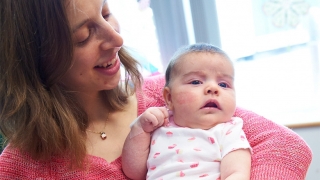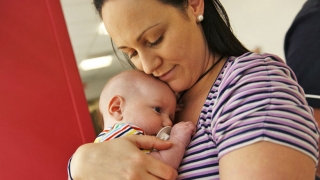Expectant parents Meghan and Alan of Plymouth, MA, started 2009 with an unexpected gift. Just four days after celebrating the arrival of the new year, they found themselves headed to the hospital for the birth of their second daughter, five weeks early.
Despite being preterm, the seemingly healthy little girl named Mackenzie arrived weighing a hefty 7 pounds 9 ounces.
Mom, Dad and big sister Casey were thrilled, but the neonatologist attending the birth immediately began asking Meghan questions: Had she had gestational diabetes? Was she diabetic? Was there any history of low blood sugar in her family?
Meghan answered ‘no’ to all the doctor’s questions, and then asked one herself: Why?
Mackenzie’s blood sugar was low — much lower than it should have been.
Assuming that Meghan had unknowingly developed gestational diabetes at the very end of her pregnancy, the infant was taken to the Special Care Nursery and given IV dextrose to correct her sugars. The new parents were told that as soon as Mackenzie had five normal blood sugars, she could come out of the Special Care Nursery.
After months of uncertainties, Mackenzie referred to CHOP
That never happened. At 5 days of age, Mackenzie was transferred from the local hospital to the NICU of a large university hospital in Boston.
Over the next month, Mackenzie required more and more dextrose to keep her sugars stable, and she was seen by geneticists, endocrinologists and metabolic doctors, all looking for the cause of her chronic low blood sugars.
Finally, one of the endocrinologists considered hyperinsulinism as the cause, and tested her for it. The results all came back consistent for the disease. Mackenzie also had genetic tests ordered for the congenital form of hyperinsulinism, but those test results would take four to six weeks to come back.
Treatment was started, and at 8 weeks of age Mackenzie was discharged from the NICU.
The next month at home was extremely difficult for the family. Mackenzie needed to be fed every three hours around the clock to maintain her blood sugar above 40 mg/dL. She had severe reflux, and if she spit up, her sugar level would immediately drop into the 30s, so she’d have to be fed again instantly. It was a never-ending cycle.
At Mackenzie’s next appointment, her parents stressed that something more needed to be done — something was wrong. And they were right.
The results of Mackenzie’s genetic tests had finally come back, and they were positive. Mackenzie had a genetic mutation compatible with focal congenital hyperinsulinism, meaning it was possible that a small area of her pancreas was affected.
Armed with this new information, Meghan and Alan asked the doctor about their next steps. He replied “If this were my child, I would bring her to The Children’s Hospital of Philadelphia”.
And so they did.
Diagnosis and treatment of Mackenzie's focal HI
“The first day I was at CHOP, I was so impressed,” Meghan remembers. “And I felt so relieved! Clearly they knew what was going on, and what to do, every step of the way. They were on top of their game, and made me feel the most comfortable I’d felt since she was born.”
Mackenzie was quickly scheduled for a 18F-DOPA PET scan which revealed a focal lesion on her pancreas. Less than a week later, she was scheduled for surgery to remove the small portion of her pancreas that was affected.
“The nurse kept us informed during the surgery, which was great," Meghan says. "And afterwards, the surgeon, Dr. Adzick came out and talked to us.”
Mackenzie spent the following week in the Newborn/Infant Intensive Care Unit recovering from her surgery, and was then moved to the regular patient floor.
A few days before being discharged, Mackenzie and her mom were napping when Mackenzie spit up in her sleep. When Meghan woke up several hours later, she saw that the baby had spit up and called the nurse in a panic, remembering the days when Mackenzie’s sugar levels would plummet as soon as she vomited.
The nurse quickly tested Mackenzie’s blood, and the result was staggering; her blood sugar level was still normal at 115 mg/dL.
“It had never been 115, ever!! I was stunned, excited and relieved, all at the same time,” Meghan says.
Mackenzie was discharged a few days later, on her 4-month-old birthday, and returned home to Massachusetts with her parents.
Growing up after HI
Today she is a happy, developmentally appropriate 7-month-old who loves eating and who now sleeps through the night.
She will return to CHOP at the end of August, 2009, for her final “cure fast.”
If she passes this test, she will be considered cured from her HI, and her parents will never have to think about HI ever again. And based on her progress over the past three months, Meghan is sure Mackenzie will pass with flying colors.
Originally posted: August 2009

